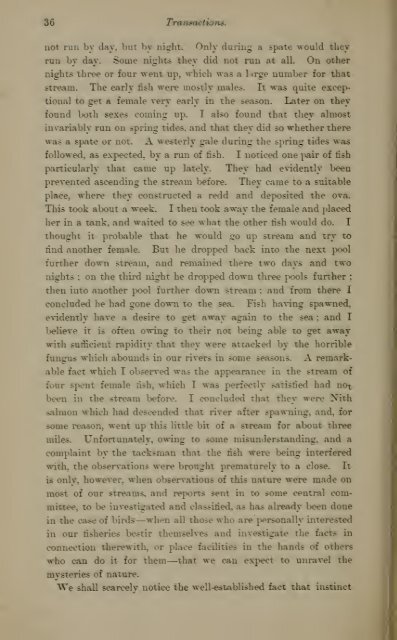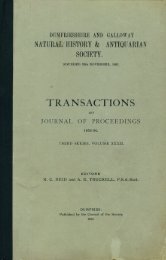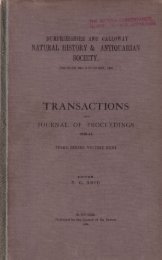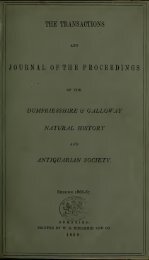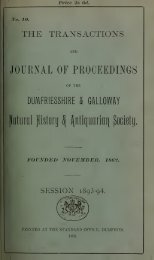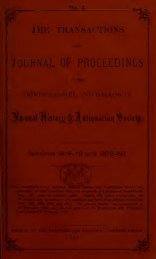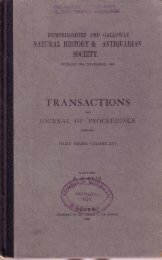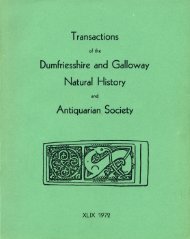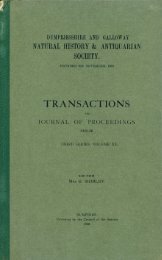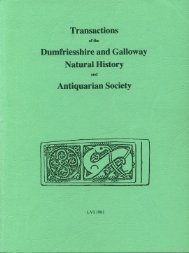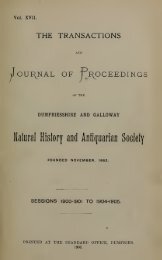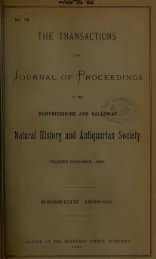36 Tran.sactions.not run by day, but by night.Only during a spate would theyrun by day. Some nights they did not run at alL On othernights three or four went up, which was a Lirge number for thatstream. The early fish were mostly males. It was quite exceptionalto get a female very early in the season. Later on theyfound both sexes coming up. I also found that they almostinvariably run on spring tides, <strong>and</strong> that they did so whether therewas a spate or not. A westerly gale during the spring tides wasfollowed, as expected, by a run of tish.I noticed one |^ir of fishparticularly that came up lately. They had evidently beenprevented ascending the stream before.Tliey came to a suitableplace, where they constructed a redd <strong>and</strong> deposited the ova.Tliis took about a week.I then took away the female <strong>and</strong> placedher in a tank, <strong>and</strong> waited to see what the other fish would do.thought it probable that he would go up stream <strong>and</strong> try tofind another female. But he dropped back into the next f)oolfurther down stream, <strong>and</strong> remamed there two days <strong>and</strong> twonights ; on the third night he dropped down three pools further ;then into another pool further down stream ; <strong>and</strong> from there Iconcluded he had gone down to the sea- Fish having spawned,evidently have a desire to get away again to the sea ; <strong>and</strong> IIjelieve it is often owing to their not being able to get awaywith sufficient rapidity that they were attacked by the horriblefungus which abounds in our rivers in some seasons. A remarkablefact which I observed was the appearance in the stream offour spent female fish, which I was perfectly satisfied had notbeen in the stream befoi-e. I concluded that they were Nithsalmon which had descended that river after spawning, <strong>and</strong>, forsome reason, went up this little bit of a stream for about threemiles. Unfortunately, owing to some misunderst<strong>and</strong>ing, <strong>and</strong> acomplaint by the tacksman that the fish were being interferedwith, the observations were brotight prematurely to a close. Itis only, however, when observations of this nature were made onmost of our streams, <strong>and</strong> reports sent in to some central committee,to be investigated <strong>and</strong> classified, as has already been donein the case of birds—when all those who are personally interestedin our fisheries bestir themselves <strong>and</strong> investigate the facts inconnection therewith, or place facilities in the h<strong>and</strong>s of otherswho can do it for them—that we can expect to unravel themysteries of nature.We shall scarcely notice the well-established fact that instinctI
Transactions. 37leads the salmon to return year after year to its native stream,<strong>and</strong> which lias a striking parallel among birds, as in the case ofthe swallow, but pass on to other migratory fishes, first noticingthe eels. Unlike the salmon, the eels spawn in the sea, if theydo spawn at all. At anyrate, they went down to the sea tobreed, <strong>and</strong> they came back again up the rivers ; <strong>and</strong> we find thatthe elvers, or young eels, come up about the month of May inlarge shoals. The older eels come up <strong>and</strong> run on spring tides,never waiting for a spate.The herring migrate, not to <strong>and</strong> from the Arctic regions, aswas repoi^ted by all the older naturalists—worthy men in theirtime, <strong>and</strong> who have h<strong>and</strong>ed down to us a lotof erroneous information—butsimply from deep toshallow water, <strong>and</strong> remain, Ibelieve, vei'y near our isl<strong>and</strong>s all tlie time. Their migration isvery largely dependent upon temperature. To give an idea oftlie extraordinary numbers of the herring, if we allow one herringfor every cubic foot, <strong>and</strong> assume a shoal to be a square mile inextent <strong>and</strong> eighteen feet deep, it would contain five hundredmillions of the fish. And there were a great many shoals ofvastly larger dimensions. Such were their immense quantity,<strong>and</strong> such their rapid rate of increase, that the' whole quantitycaught by man did not appreciably afiect their numbers, <strong>and</strong>they would choke up the sea if they were not eaten by other fishes.One of the fishes most destructive to the herring was the cod,which followed the shoals, <strong>and</strong> has been found very frequently inthe Solway now in the winter, at spots where the haddock usedformerly to be plentiful, but from which it ha.s disappeared.II. The Si/stem of L<strong>and</strong> Tenure in Scotl<strong>and</strong>.By Mr J. "W. Whitelaw.In this paper the author remarked that the system of l<strong>and</strong>tenure in Scotl<strong>and</strong> was of feudal origin, but that very littlefeudalism now remained except in nomenclature, <strong>and</strong> the theorythat the sovereign is the source <strong>and</strong> fountain of all rights in thel<strong>and</strong>. He traced tlie history of Feudalism from the earliesttimes, showing how the various changes were introduced, <strong>and</strong>described the rites <strong>and</strong> ceremonies of investure.
- Page 1: THE TRANSACTIONS•^^g^feJOURNAL OF
- Page 4 and 5: —" How charming is Divine Philoso
- Page 6 and 7: ——————CONTENTSPaficSecr
- Page 8 and 9: I2 Transactions.crops in the old wo
- Page 10 and 11: 4 Transactions.Glasgow Geological S
- Page 12 and 13: —Transactions.5th November, 1886.
- Page 14 and 15: I8 Transactions.and is very irregul
- Page 16 and 17: \10 Tronmrtiotis.jig ; H. cracatum
- Page 18 and 19: 12 Transactions.the rebellion of 17
- Page 20 and 21: ..14 Transactions.Society were acco
- Page 22 and 23: 61Trani^nctionH.constantly in motio
- Page 24 and 25: 8;1Transactions." Meteorology," in
- Page 26 and 27: —20 Tra/HsactioHS.Provost or Alde
- Page 28 and 29: 22 Traitsactions.Scotland, as in th
- Page 30 and 31: —24 Transactions.the Lower orWlii
- Page 32 and 33: 26 Transactions.long supported and
- Page 34 and 35: Languendo,—28 Transactions.Uh Mar
- Page 36 and 37: DeiMag30 l^ranadtctiond.wood, shape
- Page 38 and 39: 32 Transactions.in the sea for the
- Page 40 and 41: 34 Transactions.a good deal here. I
- Page 44 and 45: ;38 Transactions.\st April, 1887.Dr
- Page 46 and 47: 40 Transnctio7is.guessed it to be o
- Page 49 and 50: —Transactions. 41ancient British
- Page 51 and 52: —Transactions.'43as the Milton Pa
- Page 53 and 54: IWansactions. 46one I have noticed
- Page 55 and 56: —Transactions 47Some two hundred
- Page 57 and 58: •~?lATt. 1 =^YPr 1.© © ©€* e
- Page 59: Tlats H .HOMPSON ,S;^TONE'Photo -Ti
- Page 63: -RZZ-TlATX- IT.^T••MiGH BRINKSS
- Page 67: TiATE^ITHt: CiAcHANliOLU STONE(BOBG
- Page 71 and 72: —Trannactions. 49type.But its fel
- Page 73 and 74: Transactioiis. 51portion which is d
- Page 75 and 76: Transactions. 53considerable length
- Page 77 and 78: —TransartionR. 55The genus Didymo
- Page 79 and 80: Transactions. 57while Mr Carruthers
- Page 81 and 82: Field Meetings.59From the churchyar
- Page 83 and 84: Field Meetings. 61was obtained. lu
- Page 85 and 86: —Field ^feetin
- Page 87 and 88: —Field Meetings.'65levying; duos.
- Page 89 and 90: Field Meeting8. 67ings in the neigh
- Page 91 and 92: Appendix.G'JNATURAL HISTORY DIVISIO
- Page 93 and 94:
—Apprndix. 71smaller birds— by
- Page 95 and 96:
wlio was an honorary burgess of the
- Page 97 and 98:
— —Appr.ndix. 75—R. B."Table,
- Page 99 and 100:
Appendix. 77James Litiljohne, &c.,
- Page 101 and 102:
——;Appevi/ix. 79Manuscripts.
- Page 103 and 104:
—"——Appendii: 81Thomas Huttou
- Page 105 and 106:
——— ——————Appendi
- Page 107 and 108:
APPENDIX B.LIST OF MEMBERS OF THE S
- Page 109 and 110:
,,,5th Nov.,3d Fel>y.,5th July,•2


